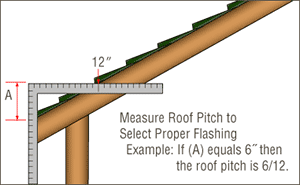Jun 8th 2020
How to Measure Roof Pitch
Not quite sure what your roof pitch is? Let us help! The pitch, or slope, of a roof is expressed as the distance a roof raises vertically over a 12-inch horizontal distance. So a roof that rises 6 inches vertically for every 12 inches horizontally has a 6/12 pitch.

To measure your roof pitch:
- Set your ladder on the side of your house so that you can safely access the down slope edge of the roof. You will not need to get on the roof for this step, just make sure that you can touch the edge of the roof from the ladder. As you face the house, the roof should slope up from the left to right, not away from you.
- Hold a framing square up against the roofline so that the long end of the "L" points toward the center of the roof and the short end points toward the ground. Essentially, you are forming a right triangle with the long and short sides of the framing square - the roof edge forms the third side.
- Position the framing square so that the long end meets the edge of the roof at the 12" mark.
- Level the square horizontally.
- Read the measurement on the short end that is standing up vertically from the roof.
- :::Remember::: Rise over run. The rise is the measure on the vertical leg; the run is the 12" measurement on the horizontal leg. So if the vertical measurement is 6, the roof has a 6/12 pitch.
Roof pitch relates to the slope and inclination angle of a roof in building construction. The primary purpose of a pitched roof is to redirect rainwater. In general, the pitch of the roof is proportional to the amount of precipitation. Houses in areas of low rainfall frequently have roofs of low pitch while those in areas of high rainfall and snow have steep roofs.
Now knowing your roof pitch you can choose the proper roof flashing for your chimney installation. Flashings generally cover a range of pitches. Example; a 0/12 to 6/12 covers a flat roof to a 6/12 pitch roof.

